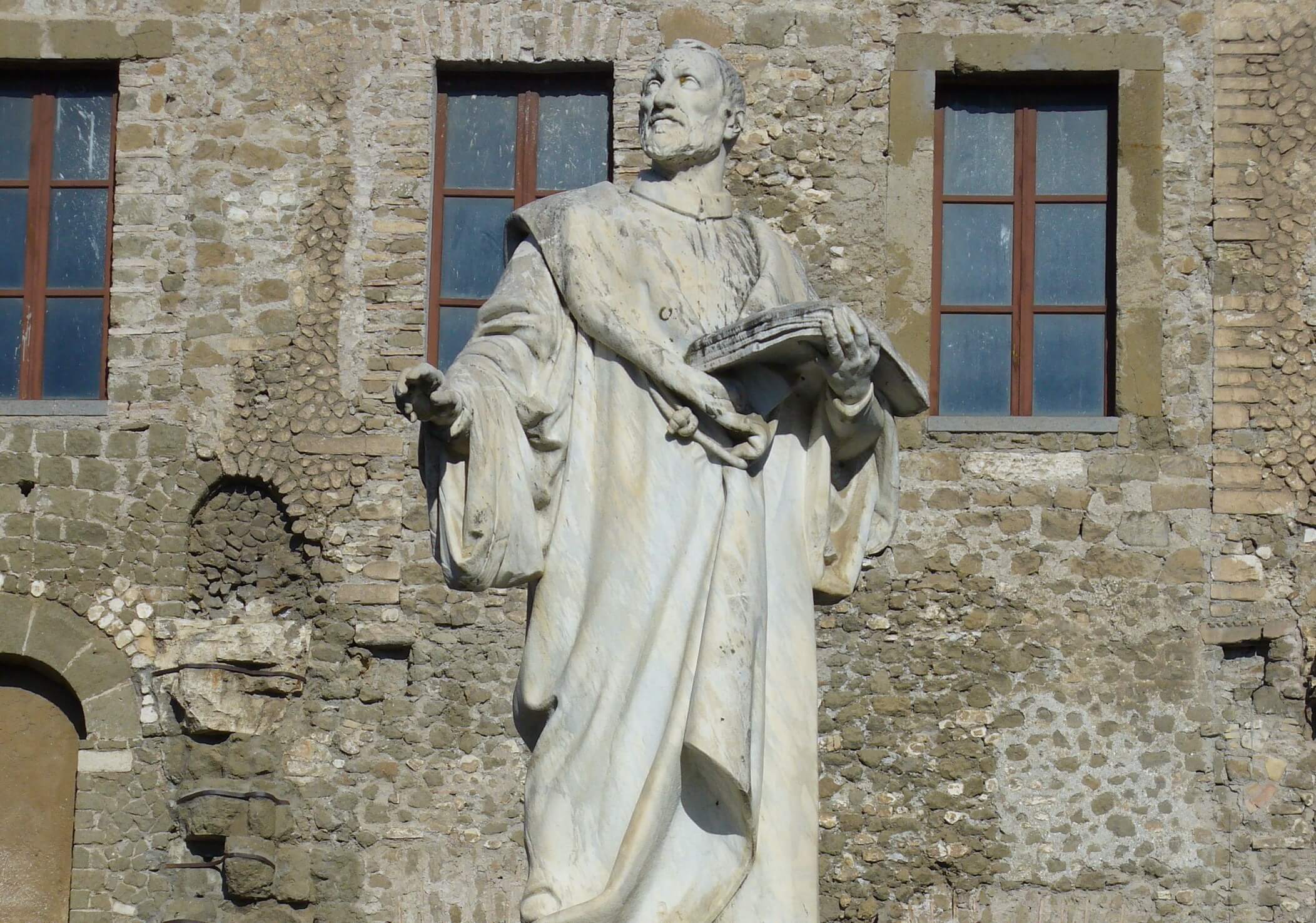One hundred years ago today, the city of Palestrina inaugurated the monument dedicated to the greatest son of this ancient town located 23 miles east-southeast of Rome, Giovanni Pierluigi da Palestrina, the “Prince of Music” born here in 1525. It is the fine statue by the Florentine sculptor Arnaldo Zocchi (1862-1940) which stands in the central Piazza Regina Margherita, next to the Cathedral of St. Agapitus.
They wanted to erect such a monument almost thirty years earlier, on February 2, 1894, on the occasion of the third centenary of the composer’s death, but there were all kinds of difficulties. In May 1907 the Canons of St. Peter’s asked for support, recalling that “the supreme Palestrina was for many years maestro of the Cappella Giulia of the Vatican Basilica, for which he composed very famous polyphonies.”[1]
A suggestive description of the sculpture is offered to us by the speech said in Palestrina on the day of its inauguration by the undersecretary of fine arts, Giovanni Rosadi from Lucca (1862-1925):
The majestic figure is portrayed in the act of asking inspiration from heaven; his hand holds the masterpiece, the Mass consecrated to Pope Marcellus; the right hand marks the rhythm of the inspired singing. Acting as a magnificent back to the monumental work the cathedral, where the maestro increased his education on the organ and with the direction of the choir, and, in its mutilated remains, the ancient temple dedicated to Fortuna Primigenia, a fortune that we too will invoke for the future of the homeland and its genius, but not invoking it from the knees of Jupiter and superstition, but from the nobility of purpose and the descendants of our destinies. Highest and most inspiring monument may this virtue of purpose and this awareness of destines be, today renewed in our souls in the presence of another Lord of the highest song and in the hour that we give him a solemn testimony of our immortal veneration and gratitude.[2]
Pope Benedict XV (1854-1922) also wanted to be spiritually present by sending Cardinal Vincenzo Vannutelli (1836-1930), Bishop of Ostia and Palestrina and Dean of the Sacred College of Cardinals, as his representative to the celebration. How much importance the Pope of peace attributed to this circumstance can easily be seen in his noble letter, written for the occasion: “the monument that the town of Palestrina raises to its great son and the inaugural celebration, which is announced in a particular solemn way, deserve special consideration by the Apostolic See.”[3]
However, the interest of the pope of Genoese origin in the honors of the ancient Præneste, as well as ours, went further: “it must serve to promote ever more that fervor of musical restoration, which, happily initiated by Our predecessor of venerable memory, in the first year of his pontificate, spread and intensified in all regions of catholicity.”
The musical restoration was the one desired by Pope St. Pius X eighteen years earlier with his Instruction on Sacred Music, “as to a juridical code of sacred music,” written with the intention that nothing should have place
In the temple calculated to disturb or even merely to diminish the piety and devotion of the faithful, nothing that may give reasonable cause for disgust or scandal, nothing, above all, which directly offends the decorum and sanctity of the sacred functions and is thus unworthy of the House of Prayer and of the Majesty of God.[4]
Benedict XV did not want the fervor ignited by the “wise rules” of his predecessor to cool down, “especially as regards the classical polyphony, which, as was very well said, achieved the maximum of its perfection in the Roman School through the work of Giovanni Pierluigi da Palestrina.”[5]
Benedict XV was very keen on the reform decreed by Papa Sarto. This can be seen from how many times he encouraged its application with his word and with his generous hand: at the beginning of his pontificate, on September 23, 1914, receiving the representatives of the Italian Association of Saint Cecilia and of the Pontifical Higher School of Sacred Music in Rome; in audiences with bishops and music lovers; blessing new sacred music institutions in the United States and Spain and sending messages to participants in liturgy or sacred music congresses. This is known today as the Pontifical Institute of Sacred Music: the school, established by St. Pius X in 1910 and opened on January 3, 1911, was actually founded by Benedict XV, who on July 10, 1914, with a rescript of the Secretariat of State, declared it Pontifical and granted it the power to confer academic degrees.
Those saddened by the times we live in, those of cancel culture (more cancel than culture, to tell the truth), which painfully exalt the rejection of history, might find some consolation with the citizens of Palestrina, who a hundred years ago paid honor and gratitude to the greatest or their sons and the same they did thirty-two years later, as seen in a Italian newsreel of October 29, 1953. And, in the field of sacred music, might find some consolation with those who acted for the glory of God, for the dignity of worship and for the renewal of the Cristian spirit, responding to the expectations of St. Pius X and Benedict XV, who closed his letter saying: “In this way the faithful, gathered in prayer in the temple of God, will be more easily excited to devotion and better disposed to welcome the fruits of grace.”[6]
Photo: wiki commons.
—
[1] Cf. G. Rostirolla, La Cappella Giulia 1513-2013: Cinque secoli di musica sacra in San Pietro, Bärenreiter, Kassel 2018, p. 1107.
[2] In Conferenze e prolusioni: periodico quindicinale fondato nel 1908 da Federico Garlanda, Società editrice laziale, Turin 1921, p. 358.
[3] Benedict XV, Non senza vivo, September 19, 1921.
[4] Pius X, Tra le sollecitudini, November 22, 1903.
[5] Benedetto XV, ibidem.
[6] Ibid.


